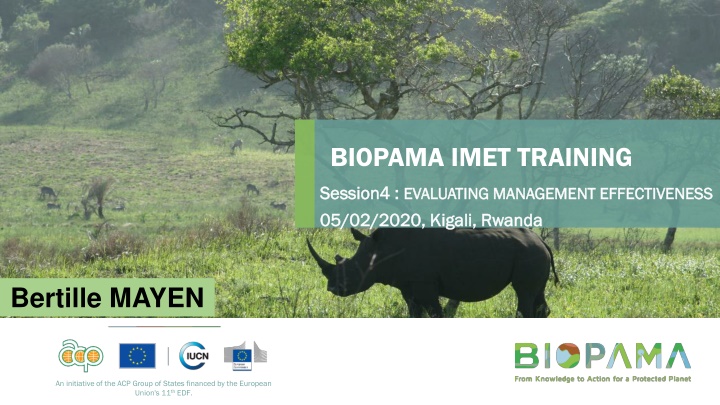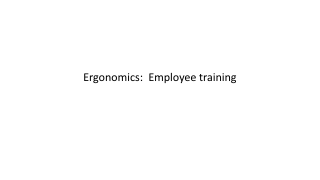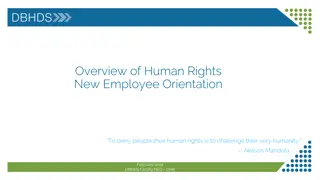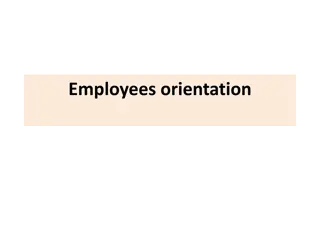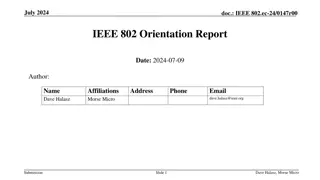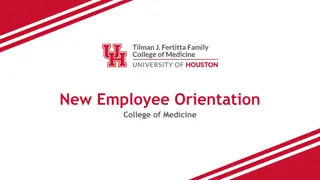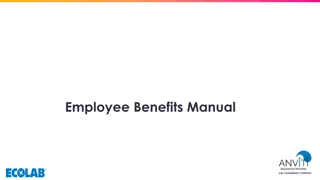New Employee Safety Orientation and Responsibilities
In the New Employee Safety Orientation at the University of Utah, learn about occupational and environmental health and safety. Discover the structure in place, support from senior leadership, responsibilities for all personnel, supervisors, and administrators. Understand the importance of training, hazard reporting, and creating safe work environments.
Download Presentation

Please find below an Image/Link to download the presentation.
The content on the website is provided AS IS for your information and personal use only. It may not be sold, licensed, or shared on other websites without obtaining consent from the author.If you encounter any issues during the download, it is possible that the publisher has removed the file from their server.
You are allowed to download the files provided on this website for personal or commercial use, subject to the condition that they are used lawfully. All files are the property of their respective owners.
The content on the website is provided AS IS for your information and personal use only. It may not be sold, licensed, or shared on other websites without obtaining consent from the author.
E N D
Presentation Transcript
BIOPAMA IMET TRAINING Session4 : Session4 : EVALUATING MANAGEMENT EFFECTIVENESS EVALUATING MANAGEMENT EFFECTIVENESS 05/02/2020, Kigali, Rwanda 05/02/2020, Kigali, Rwanda Bertille MAYEN An initiative of the ACP Group of States financed by the European Union's 11thEDF.
LEARNING OBJECTIVE At the end of the session, participants will be able to: Demonstrate an understanding of the six elements of the IMET Evaluation; and Complete an IMET Assessment Form.
Management Effectiveness Adaptive Management Countries, governments , PA managers, partners, donors and stakeholders have different expectations when it comes to PAs management >50% >33.9% >34.50% IMET provides a framework to assist the PA Managers / partners to track & monitor progress in the achievement of a PA management objectives ; PA Management effectiveness entails monitoring the performance of the PA through the 6 stages of a PA management cycle as defined by IUCN to view progress towards improving management effectiveness.
UNDERSTANDING THE SIX ELEMENTS OF THE IMET ASESSMENT The IMET Form contains various elements of a PA management effectiveness analysis based on the management cycle of a protected area as developed by UICN. (ref: Prof. Hockings et al). The management effectiveness evaluation is divided into six steps as shown below : 1. Management context 2. Planning 3. Inputs 4. Process 5. Outputs 6. Outcomes 6 4 5 3 2 1
1st ELEMENT: The CONTEXT Where are we now? Here we are concerned with the analysis of the state of conservation and other values of a PA, its current status, the threats that it faces and the opportunities available, as well as the overall political context. When carrying out an IMET assessment to establish a list of management priorities within a network of PA, or to determine the time and resources which need to be allocated, this is one of the key step to take. The WCPA (World Commission on Protected Areas) framework on which the IMET draws from is based on the principle that effective management of a PA consists of six stages / elements, as follows: 1. A PA management begins with understanding the Context of the values and threats; 2. It progresses through Planning for the organization of interventions targeting well defined goals; 3. Allocates Inputs (resources); and 4. Implements management actions according to accepted Processes; and 5. Eventually produces Outputs (goods and services); 6. That result in impacts or Outcomes, hopefully achieving agreed conservation goals and objectives.
2nd ELEMENT: PLANNING What achievements do we want? What results do we hope to achieve for our PA. This step focuses on assessing the adequacy of the PA with regard to legislation & national policy. The main aim is to assess the planning component of a PA according to the integrity & status of the resources available on site.
3rd ELEMENT: INPUTS-INTRANTs What do we need? We need to analyze the adequacy of resources to achieve the management objectives of a network or site, based mainly on the assessment of human capacity, funds, equipment, and facilities, within the institution in charge or on site. It s important to pay special attention to partners and their various contribution to the well being of the PA and that of the communities
4th ELEMENT: PROCESS PROCESS Evaluation is done through the analysis of the 6 key areas of the PA processes . These 6 areas are further subdivided in 18 elements Internal managementsystems & Processes Protection & management Stakeholder relations Tourism management Monitoring & research Management of climate changeeffects& ecosystem services How can we do it? We assess the adequacy of management systems & processes to achieve the management objectives of a network or site. By so doing we integrate a variety of indicators, i.e: site maintenance, adequacy of cooperation with local communities, different types of natural & cultural resources management.
5th ELEMENT: OUTPUTS What did we do and which products or services were produced? Assessing outputs is about examining whether the PA management has achieved the actions set out in the management plan. It s the analysis of the number/level of products & services delivered as well as the extent to which actions, tasks & strategies were implemented. It focuses on the degree of achievement of identified activities or targets. Targets are found in the management plans and annual work programs.
6th ELEMENT: OUTCOMES TANGIBLE MEASURE OF MANAGEMENT EFFECTIVENESS What did we achieve? We need to examine whether the Management Team did achieve the set objectives in the management plan, in the annual work plan or in the national plan as well as the targets corresponding to the PA category (ref: IUCN). It implies a long-term monitoring of a PA concerning the state of the resources and other area of the management of a PA, including the impact of the PA on local communities.
COMPLETE AN IMET ASSESSMENT FORM IMET Form contains different sections into which the user provide data concerning the intervention context & management effectiveness of the PA . The form assist the user to design / determine objectives, priority results, to craft recommendations or guidelines in order to improve the PA management effectiveness. It paves way for critical thinking and aids the PA managers to move toward making informed decisions and preparing action plans favorable to biodiversity conservation, local community development and sustainable natural resource management.
COMPLETE AN IMET ASSESSMENT FORM Results are represented using charts that provide a visual presentation of the analyses to support decision making. IMET Assessments are made according to a 0 1 2 3 scale or evaluations of a trend use a scale of 0-100 based on statistical criteria and formulas. IMET Form is designed to proposed a set of questions which must be answered through a scoring system as follows: a). A scale of 0 1 2 3 to evaluate negative impacts / deterioration of the PA values; b). + 1 /+ 2 /+ 3 scores to evaluate improvement. NB: scores displayed are not the absolute assessments. However, it s a picture representing the evaluation in order to show case in a visual manner the analyses.
COMPLETE AN IMET ASSESSMENT FORM Charts, radars and graphics are provided at the end of the assessment to give the user a quick visual .
The Biodiversity and Protected Areas Management Programme (BIOPAMA) is an initiative of the ACP Group of States financed by the European Union's 11th EDF.
